By Chelsea Yates
Photos by Mark Stone / University of Washington
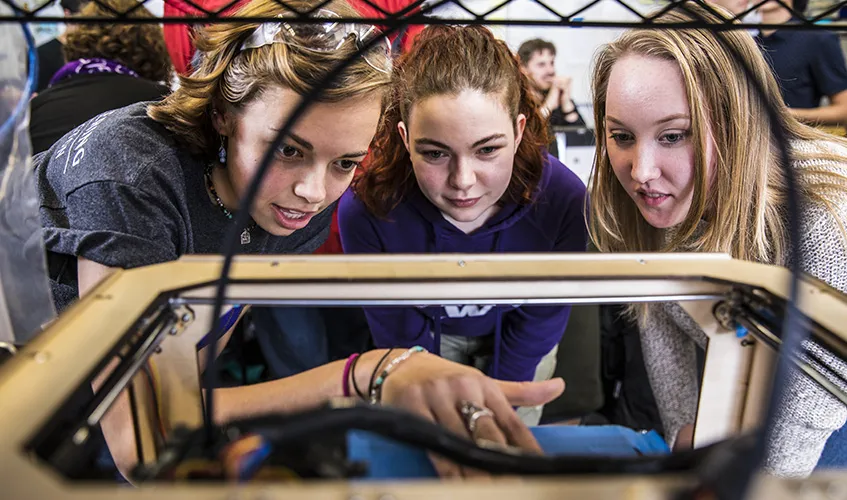
Sierra Simmerman (left), Ashley Piggott (center) and Madison Johnson (right) tweak one of the club’s 3D printers.
It’s the second Tuesday of the month, and the WOOF 3D Print Club is buzzing with activity. Students are spread throughout the Mechanical Engineering (ME) building, some attending an introductory workshop in a second-floor classroom and others in the club’s basement workspace, known as the WOOF Room. There, against the steady hum of FDM printers, club members finalize 3D models on their laptops, slicing them into layers before they’re uploaded for printing. A few students compare 3D scans of a Tyrannosaurus Rex tooth fossil. One tweaks a 3D printer that she built from scratch.
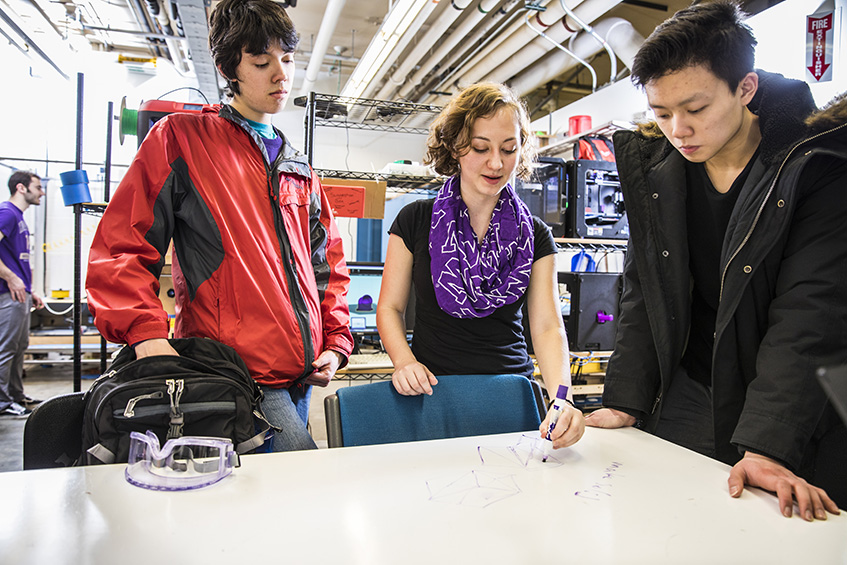 “One of our main goals in WOOF is to help others understand its value and how it can enhance their work,” says Casi Goodman (center) with Liam Waddell (left) and Marverick Tjeng (right).
“One of our main goals in WOOF is to help others understand its value and how it can enhance their work,” says Casi Goodman (center) with Liam Waddell (left) and Marverick Tjeng (right).According to Casi Goodman, a ME senior and one of this year’s club officers, this sort of project diversity is what makes the print club thrive.
“Our members come from many different majors and with a variety of interests, so flexibility and accessibility are key to how WOOF operates,” she explains.
A fast, affordable way to implement ideas, 3D printing can be used to print anything from everyday objects for the home or office to advanced materials, like biomaterials and renewable solar cells. When compared to traditional industrial manufacturing methods, it creates less waste and requires less material to produce complex shapes. It’s a growing technology, one in which students like Goodman see a lot of opportunity.
Creative community
Established in 2012, the Washington Open Objects Fabricators 3D Print Club — WOOF for short — is a UW student organization focused on advancing 3D printing technologies through education, skills development and project-based work. Housed in ME, the club consists of about 40 members. Although most are engineering students, they believe in the technology’s potential for impact across all disciplines.
“3D printing is an incredibly accessible but underused technology that can be applied to any field,” Goodman says. “One of our main goals in WOOF is to help others understand its value and how it can enhance their work.”
Originally known as Fabbers@UW, WOOF was started by three students of ME professor Mark Ganter’s additive manufacturing classes. According to Ganter, who serves as one of WOOF’s faculty advisers, the club has been at the forefront of many big projects since its inception: designing and building the largest student-made 3D printer on campus, 3D printing 3D printers for sustainable manufacturing, even creating the world’s first 3D printed boat, which was raced in Seafair’s Milk Carton Derby.
“Student organizations can provide a space for engineering students to set their own course, and that’s certainly been the case with WOOF,” says Ganter. “There are many 3D printing applications that have yet to be explored, and that’s exciting for students. It encourages them to be creative and playful while also honing their engineering and problem-solving skills.”
 Club members build and maintain most all of WOOF’s 3D printers themselves. Here, Ray Guthrie (right) levels the club’s newest printer while Adam Shimabukuro looks on.
Club members build and maintain most all of WOOF’s 3D printers themselves. Here, Ray Guthrie (right) levels the club’s newest printer while Adam Shimabukuro looks on. 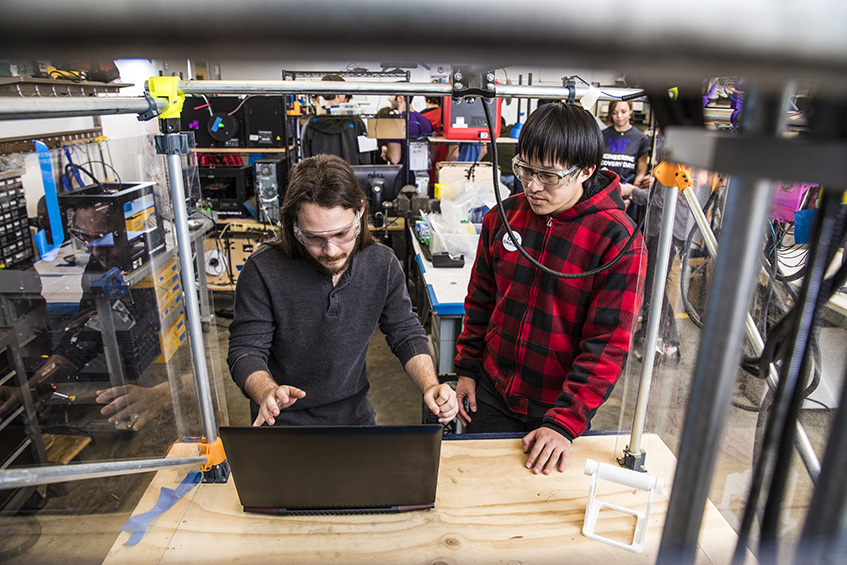 Team members Isaac Chappell (left) and Daniel Vu (right) go over the commands and software for Dino Cut, a student-built 3D printer.
Team members Isaac Chappell (left) and Daniel Vu (right) go over the commands and software for Dino Cut, a student-built 3D printer.In addition to monthly workshops and talks by industry professionals, the club hosts weekly drop-in hours in the WOOF Room. There, students can ask questions and test new designs and materials on the printers, which range from desktop size to large-scale (the biggest being “Big Blue,” with a 1m x 1m x 1.5m build space). Most all of the printers have been developed in-house, so club members take part in learning how to design, build and maintain them.
Outreach and project-based learning
WOOF is committed to outreach, and this year the club has taken on more than a dozen unique projects with campus and community partners. These projects not only illustrate the value of the technology, but they also provide WOOF students with real-world, experiential opportunities to hone their technical, communications and leadership skills.
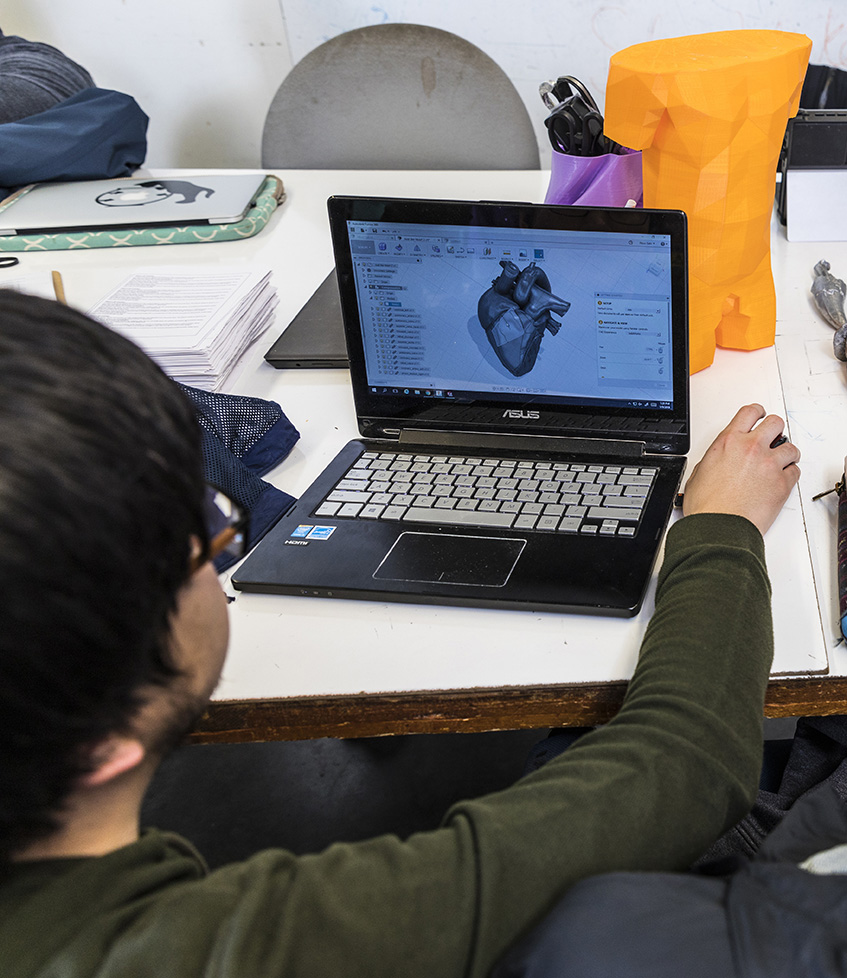 Ricky Sato reviews a 3D model of a human heart before printing. The club is working with UW Medicine’s CREST to 3D print medical training materials, such as molds for synthetic organs and tissue.
Ricky Sato reviews a 3D model of a human heart before printing. The club is working with UW Medicine’s CREST to 3D print medical training materials, such as molds for synthetic organs and tissue.For example, WOOF recently started working with the Museum of Flight on several projects to enhance museum exhibition display and visitor experience. Some club members are exploring how to replicate the museum’s moon rock — in terms of size, shape, color and density — so that visitors can touch the replica to get a sense of how the real moon rock feels, since handling it is not permitted. Others are 3D printing replicas of broken and missing parts to complete a B-29 airplane for exhibition. And a few students are collaborating with museum staff to 3D scan and print small-scale replicas of aircraft and other artifacts for the museum’s guided “Touch the Sky” sensory tours so that vision-impaired visitors can experience these objects through touch.
The club is also partnering with UW Medicine’s Center for Research in Education and Simulation Technologies (CREST) to 3D print medical training materials, such as molds for synthetic organ and tissue models. Junior biology major Sierra Simmerman serves as the club’s project coordinator and is involved with the CREST collaboration.
“If you can scan it, we can print it. That applies to our bodies and the biology fields, too, and one of our projects is to develop a mold for a synthetic human heart from accurate biosynthetic material based on medical scan data from real human hearts,” she explains.
When they complete that project, they will start on a detailed replica cross-section of a human arm — complete with synthetic skin, bones, tendons and arteries.
“Working with CREST through WOOF has been a great way to combine my interests in 3D printing and biology,” Simmerman adds. “Knowing that we’re creating devices for medical training is really cool, and I can’t wait to start working on the arm.”
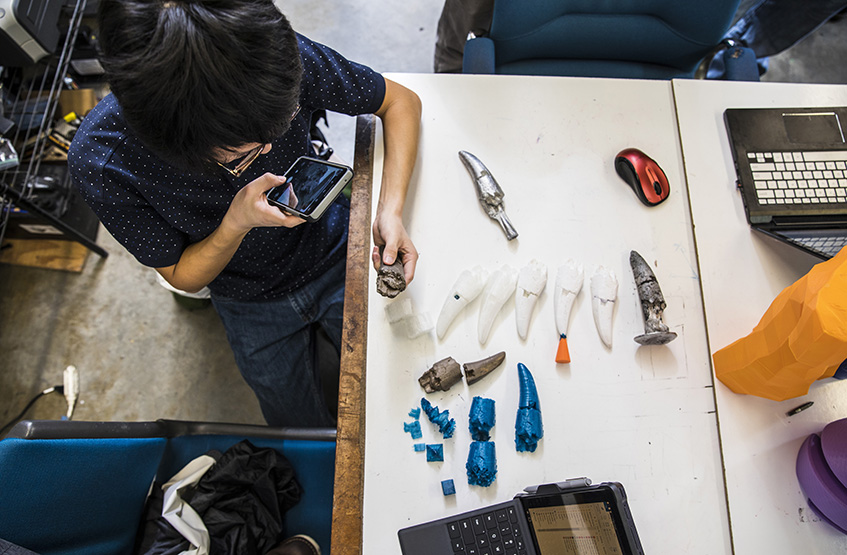 As Richard Chun shows here, the club has been experimenting with different materials to 3D print replicas of a Tyrannosaurus Rex tooth from the Burke Museum’s collection. The end goal is to print it in bronze.
As Richard Chun shows here, the club has been experimenting with different materials to 3D print replicas of a Tyrannosaurus Rex tooth from the Burke Museum’s collection. The end goal is to print it in bronze.Since 2015, WOOF has collaborated with the Burke Museum of Natural History and Culture to 3D scan and print replica bones to complete a Columbian Mammoth skeleton for the museum to exhibit when it opens its new building in 2019. Club members have also recently started investigating how to 3D print in bronze a replica of a tooth from the Tyrannosaurus Rex skeleton unearthed by Burke paleontologists in 2016. Another cluster of students is working with Burke Museum curator Sharlene Santana, who researches how and what bats eat by examining their skulls and jawbones, to 3D print enlarged replicas of bat skulls for better study.
It’s not common for engineering student clubs to be committed to as many partner projects as WOOF is, and while that has presented some challenges, Goodman says it’s also allowed for some unique opportunities.
“Our work is no longer just about figuring out how to print or how to build printers; it’s become more about how to work across disciplines, listen to and understand our partners’ needs, and manage our time and resources,” she explains.
“In WOOF we like to think of what we do as ‘passion-driven engineering’,” she adds. “We’re passionate about 3D printing and the more we can share that passion with others, the better.”
Interested in getting involved with WOOF? Learn more.
Originally published February 5, 2018